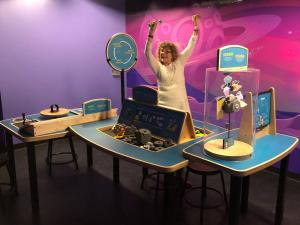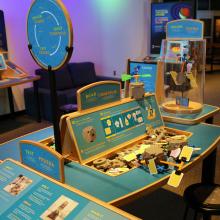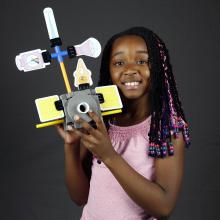In January 2018, four test copies of the Design>Build>Test engineering activity exhibit from the Sun, Earth, Universe exhibition were deployed to the following satellite locations: Science Museum of Minnesota (Saint Paul, MN), Museum of Science (Boston, MA), Sciencenter (Ithaca, NY) and Port Discovery (Baltimore, MD).
This interactive exhibit allows visitors to design, build and test their own foam spacecraft model and equip it with key tools needed to complete a NASA mission. Focused on the engineering and design process, this exhibit includes three stations:
-
Design: Real missions and visitor created spacecraft inspire visitors planning their own craft. Designers should include the key tools to accomplish their proposed mission.
-
Build: Visitors build a spacecraft from plastic, foam and cardboard pieces.
-
Test: Visitors test their spacecraft using a parts checklist, spin test and shake test.
After two months of strenuous visitor testing at these different locations we have observed very long dwell times, utilization by builders of all ages and the creation of some truly inspired spacecraft! Thanks to staff, volunteers, and visitors at these locations for helping us test out this exhibit.
Nora Thompson from Port Discovery Children's Museum in Baltimore, Maryland enthusiastic about the Design>Build>Test interactive exhibit.
A view of the Design>Build>Test interactive at the Science Museum of Minnesota.
Two proud builders presenting their collaboratively built "Planet Super Hunter" spacecraft.
A young museum visitor holding her "Star Discoverer" spacecraft.
How to apply
The NISE Network, in collaboration with NASA, will be awarding 50 free copies of the highly interactive Sun, Earth, Universe exhibition to eligible institutions in the United States. The application for the Sun, Earth, Universe exhibition is now open; deadline to apply is May 1, 2018.
Learn how to apply here!
Acknowledgements
This material is based upon work supported by NASA under cooperative agreement award number NNX16AC67A. Any opinions, findings, and conclusions or recommendations expressed in this material are those of the author(s) and do not necessarily reflect the view of the National Aeronautics and Space Administration (NASA).




